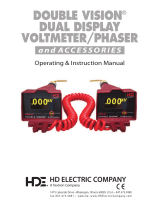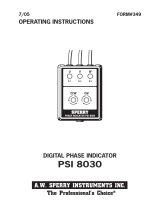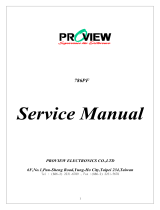
©
Copyright 2005 Hubbell Power Systems
P403-3408
rev A
Operating Instructions
for
Auto-Ranging Voltage Indicator
The equipment covered in this manual must be used and serviced only by competent,
trained personnel familiar with and following approved work and safety practices.
This equipment is for use by such personnel and this manual is not intended as a
substitute for adequate training and experience in safe procedures for this type of
equipment.
These instructions neither cover all details or situations in equipment use, nor do
they provide for every possible contingency to be encountered in relation to
installation, operation or maintenance. Should additional information and details be
desired or if situations arise which are not covered adequately for the user’s purpose,
the specifics should be referred to Hubbell Power Systems, Chance
®
.
Before operating a CHANCE
®
Auto-Ranging Voltage Indicator, thoroughly read,
understand, and follow these instructions. Keep these instructions in the device
case for future reference.
NOTICE
Catalog No.
C403-3374
Voltage
600V - 69kV
®
Do not allow universal fitting to touch any part of URD cabinet, to become grounded
in any other way, or to contact another phase as this will cause erroneous voltage
indication and could cause severe personal injury or damage to equipment.
Catalog No.
C403-3375
Voltage
69kV - 500kV
! CAUTION
! WARNING

— 2 —
Basic Function and Design
The CHANCE® Auto-Ranging Voltage Indicator (“ARVI”) is a portable tool to
confirm that a high-voltage line is de-energized prior to performing mainte-
nance. It presents field practicality over a voltmeter and obvious advantages
over traditional methods without a meter. Readings from the ARVI represent the
class of voltage that is present on the line.
The C403-3374 is designed to determine phase-to-phase voltage classes up to
69kV. The C403-3375 is designed to determine phase-to-phase voltage classes up
to 500kV. Both units consist of one section of Epoxiglas
®
pole with high internal
impedance that is encapsulated to prevent moisture penetration and mechanical
damage.
The ARVI is actually an electric field intensity meter, which is calibrated to
illuminate an LED (light-emitting diode) representing the class of voltage that
is present on the conductor. It responds to the magnitude of the field gradient
between its end probe and a floating electrode. The device indicates the combined
field intensity from all other conductors, including ground wires and grounded
equipment. If the universal fitting is close to a ground, another phase, or another
voltage source the voltage indication will tend to be high. If the universal fitting
is close to a jumper or equipment of the same phase, the indication will tend to
be low. The tool must be used with a universal pole to maintain its calibration.
The ARVI can be used as a secondary means to confirm the condition of a circuit
after principal work procedures such as visible open gaps, dispatcher hold
orders, and apparatus tag-outs have rendered the circuit de-energized.
Operation — General
To turn the unit on press and release the “Power” push button. Upon power-up
each LED will illuminate individually from the lowest voltage to the highest
followed by the audible alarm. These tests verify the function of the LED’s,
alarm, batteries, and internal circuitry. Full unit function can only be verified
using a known energized high voltage source or with the appropriate Voltage
Indicator Tester (C403-3409 for C403-3374 ARVI and C403-3431 Voltage Indi-
cator Tester for C403-3375 ARVI). Following the audible alarm the “Power / Low-
Battery” LED will flash indicating that the unit is ready for use. After use turn
the unit off by holding the power switch until the power LED turns off, or the unit
will power itself down after approximately 15 minutes of inactivity.
The unit will begin to make an audible beep and an LED will blink when the unit
senses an electric field, even when not making contact with an energized
conductor. The higher the voltage, the faster the beeping occurs. If the unit
senses constant voltage for approximately 15 seconds, it automatically goes into
its hold-mode. At that point the LED representing the voltage class being
indicated will light continuously and the beeping will become continuous for 1 to
2 seconds followed by 5 to 6 very rapid beeps and a brief period of silence. The unit
then will return to the normal audible mode, but one LED will remain solid until
reset. Remove the unit from the line and press and release the power switch to
reset the unit.
Once in the Auto-Hold mode, the ARVI must be reset for the LED's to indicate higher
or lower voltages.
! CAUTION

Ranges
The approximate voltage ranges to provide indication of each of the voltage
classes are as follows:
Voltage Class
600V
4kV
15kV
25kV
35kV
69kV
Above 80kV
Voltage Range
480V to 900V
1kV to 6.5kV
6.6kV to 17kV
18kV to 29kV
30kV to 50kV
51kV to 80kV
Over range
(all LED’s illuminate)
Accuracy
This instrument is not a voltmeter; hence the manufacturer claims no specific
accuracy and therefore no specific accuracy is to be assumed by the user.
Readings will vary with the field intensity, determined by a great variety of field
conditions including the proximity, size, and orientation of all system compo-
nents in the vicinity, both energized and grounded. Erroneous readings can
result from both electrodes being at the same electrical potential or the universal
fitting being too near another phase or ground. To avoid such field distortions,
keep the ARVI as far away as practical from all system components other than
the specific conductor being tested.
Auto-Hold
The ARVI has a hold feature built into the circuitry, which automatically holds
a reading when the unit is left on an energized conductor or senses constant
voltage for a period of approximately 15 seconds. In the hold-mode, the LED
representing the voltage range being indicated will become solid. The audible
beeping will become continuous for 1 to 2 seconds followed by 5 to 6 very rapid
beeps, then 1 to 2 seconds of silence. The unit then will return to the normal
audible mode, but one LED will remain solid until reset. To reset the unit after
a held reading is displayed, remove the unit from the line and simply press and
release the power switch.
Once in the Auto-Hold mode, the ARVI must be reset for the LED's to indicate higher
or lower voltages.
— 3 —
! CAUTION
C403-3374 ARVI ONLY
Voltage Class
69kV
115kV
161kV
230kV
345kV
500kV
above 765kV
Voltage Range
50kV to 109kV
110kV to 149kV
150kV to 199kV
200kV to 299kV
300kV to 399kV
400kV to 765kV
Over range
(all LED’s illuminate)
C403-3375 ARVI ONLY

— 4 —
This tool is not intended for continuous contact applications. Contact with
energized conductor should be limited to the amount of time required to note
indication.
To determine the approximate phase-to-phase voltage:
1. Check battery and circuitry for proper operation by pressing and releasing the
power switch. Verify full unit function by contacting with a known energized
high voltage source or with the appropriate Voltage Indicator Tester (C403-
3409 for C403-3374 ARVI and C403-3431 Voltage Indicator Tester for C403-
3375 ARVI).
2. Thread the hook probe into the end fitting of the ARVI and attach universal
fitting to an insulated hot stick of proper length for system voltage involved.
Always use appropriate length stick even if wearing rubber gloves.
Contact with universal ferrule or other part even with rubber gloves will cause
erroneous voltage indication.
Always use with a universal pole to maintain its calibration.
Test
phase
*Electromagnetic
action of
current
* Both can induce a
high static condition
on the de-energized
circuit. (Activity
shown between only
two conductors for
clarity here. Similar
effects exist
between all conduc-
tor pairs.)
ARVI indicates the combined field
intensity from all other conductors,
including ground wires.
De-energized
circuit
Energized
circuit
*Electrostatic
action of
voltage
Keep instrument clean and dry.
Do not allow universal fitting to become grounded or contact another phase as this
will cause erroneous voltage indication and could cause severe personal injury or
damage to equipment.
Always maintain proper working clearance between operator and all energized parts
of the ARVI by using proper length universal pole. Failure to follow these warnings
could result in personal injury or damage to equipment.
Operation — Overhead
! CAUTION
! WARNING

— 5 —
Interpretation of ARVI readings on Overhead
Reading
Appropriate line-to-line voltage class
No Indication
Voltage below line-to-line voltage class
Circuit Condition
Energized
De-Energized
Probably de-energized and read-
ing is due to static; however, do not
assume that circuit is de-energized.
Instead, check and confirm circuit
condition by another method.
All interpretations should take into account the circuit configuration, length, proximity
to other lines; and should be consistent with previous experience on same circuit with this
instrument. If ever in doubt about interpreting ARVI reading under any circumstance,
always assume circuit is energized and take appropriate safety precautions.
Do not allow universal fitting to touch any part of URD cabinet, to become grounded
in any other way, or to contact another phase as this will cause erroneous voltage
indication and could cause severe personal injury or damage to equipment.
Operation — Underground (URD) C403-3374 ONLY
Always use appropriate length stick even if wearing rubber gloves.
Contact with universal ferrule or other part even with rubber gloves will cause
erroneous voltage indication.
Always use with a universal pole of proper length to maintain its calibration.
When using the ARVI on underground systems, the same basic rules and
procedures apply as with overhead; for example, maintaining proper working
clearances to all parts of the tool, keeping tool clean and dry. However, the
following are two additional instructions when using the tool on underground
equipment. The readings taken in URD cabinets will typically be higher than on
an overhead line.
Do not use any probes on the ARVI when testing live-front URD equipment.
Failure to follow this warning could result in personal injury or damage to equipment.
Turn unit on by pushing and releasing the power switch.
3. Make contact with the line to be measured with the shepherd hook per the
following instructions:
a. Keep ARVI perpendicular to the phase conductor.
b. Keep ARVI away from poles or structures a distance at least twice the
circuit’s phase spacing, i.e. test out on span rather than near structure,
jumpers, risers, cutouts, insulators, ground wires and any system com-
ponents other than the conductor being tested.
c. Test three or four locations to check consistency. Where little or no
consistency is apparent, consider the highest reading as correct.
4. If the ARVI is left on the conductor for approximately 15 seconds, it will go into
the Auto-Hold mode and hold the voltage indication until reset (see Auto-Hold
section of these instructions).
! CAUTION
! WARNING
! WARNING

— 6 —
2. To test elbows or bushings on dead-front URD equipment, remove the hook
probe and install the proper elbow adapter or bushing adapter on ARVI.
Testing of elbows can be accomplished by two methods:
a. Recommended procedure (one person required): Secure an insulated feed-
thru device in a parking stand on the dead-front transformer or switch.
Pull elbow with appropriate hot line tool and install elbow on feed-thru
device. Install bushing adapter on ARVI. Insert bushing adapter into
feed-thru bushing to check elbow/cable for voltage. Insert bushing adapter
into the apparatus bushing to check bushing for voltage.
b. Optional procedure (two people required): Operator #1 pull elbow with
elbow-puller tool, then orient elbow so it is accessible with ARVI. Operator
#2 install elbow adapter on ARVI, then insert elbow adapter into elbow to
check elbow/cable for voltage.
1. Due to the close proximity of energized parts and grounded surfaces, probes
must not be used when using the ARVI on live-front URD equipment because
probes could either bridge from phase-to-phase or phase-to-ground or suffi-
ciently reduce clearance to cause flashover. Therefore the probes must be
removed from the tool. NOTE: A small hex-head machine screw (1/4-20UNC
x 3/8 long) could be inserted to protect the female thread.
Use proper elbow and/or bushing adapter when testing dead-front URD
equipment.
Failure to use proper adapters could result in personal injury or damage to
equipment.
Bushing Test
Feed-thru
device
(not
furnished)
Elbow/Cable Test
Bushing Adapter
! WARNING

— 7 —
Interpretation of ARVI readings on Underground (URD)
Reading
Appropriate line-to-line voltage class
No Indication
Circuit Condition
Energized
De-Energized
If ever in doubt about interpreting ARVI reading under any circumstance,
always assume circuit is energized and take appropriate safety precautions.
Battery Replacement
A low battery condition is indicated when the alarm chirps with no LED
indication of voltage and the “Power / Low Battery” LED flashes at an increased
rate. Batteries can be replaced by removing the four screws in the front panel,
removing the panel and replacing the four “AAA” batteries on the back of the
panel, noting proper polarity. CAUTION: Ensure that the wires connected
to the orange connector in the panel assembly remains connected and
are not damaged and the battery strap is secure. After the panel and screws
are replaced in the housing, test the function of the unit on a known energized
voltage source or with the Voltage Indicator Tester.
After replacing batteries, ensure that the wires connected to the orange connector
in the panel assembly remain connected and are not damaged. After the panel and
screws are replaced in the housing, test the unit on a known energized voltage source
or with the Voltage Indicator Tester to verify proper operation.
Optional Method
for Elbow/Cable Test
Elbow Adapter
Elbow-puller tool
T403-0856
Up to 35kV Elbow Adapter
T403-0857
Up to 35kV Bushing Adapter
T403-0428 15kV Bushing Adapter
! CAUTION

NOTE:
Because Hubbell has a policy of continuous product improvement, we reserve the right to change design and specifications without notice.
C403-3374
C403-3375
C403-3409
C403-3431
T403-0856
T403-0857
H1760-1
P643-6
H1760
P643-8
T403-3418
Auto-Ranging Voltage Indicator, 600V – 69kV includes
- Instruction manual
- Plastic Case
Auto-Ranging Voltage Indicator, 69kV – 500kV includes
- Instruction manual
- Plastic Case
Voltage Indicator Tester for C403-3374 ARVI
Voltage Indicator Tester for C403-3375 ARVI
15-35kV Elbow Adapter
15-35kV Bushing Adapter
6’ Universal Pole
Bag for two 6’ universal poles
8’ Universal Pole
Bag for two 8’ universal poles
Auto Ranging Voltage Indicator 600V - 69kv
C403-3409, T403-0857, T403-0856
Repair
If repair/calibration or parts are required,
please contact:
M.W. Bevins Co.
9903 E. 54th St.
Tulsa, OK 74146
(918) 627-1273
(918) 627-1294 (FAX)
www.mwbevinsco.com
Specifications
Operating temp: -20° to +80°C
Unit power: Four (4) “AAA” batteries
C403-3409
Voltage Indicator Tester
Care
The ARVI is an electronic instrument and, if properly cared for, will provide
many years of trouble-free service. Keep all parts clean and dry. Abuse or misuse
will damage the unit. Store in a dry location, do not drop, and protect from
jostling or impacts during storage, carrying, or use.
210 North Allen
Centralia, Missouri 65240
Phone: 573-682-5521
Catalog No. Description
P403-3408
rev A
-
 1
1
-
 2
2
-
 3
3
-
 4
4
-
 5
5
-
 6
6
-
 7
7
-
 8
8
Hubbell C403-3375 Operating instructions
- Type
- Operating instructions
Ask a question and I''ll find the answer in the document
Finding information in a document is now easier with AI
Related papers
-
Hubbell PSP4033591 Operating instructions
-
Hubbell P403-2229 Operating instructions
-
Hubbell CHANCE Nylon Thread Insulator Pin Operating instructions
-
Hubbell TD09099 Operating instructions
-
Hubbell PSP4033798 Operating instructions
-
Hubbell PSP4033798 Operating instructions
-
Hubbell P403-3194 Operating instructions
-
Hubbell IS-200BI Installation guide
-
Hubbell IS-235DBI Installation guide
-
Hubbell IS-600BE Installation guide
Other documents
-
 Avitecture ARVi Operating instructions
Avitecture ARVi Operating instructions
-
CHANCE PSC4033582 Operating instructions
-
 Hubbell Power Systems Deadbreak Connectors 15kV & 25kV 600/900 Amp Products (AIK-CABA-IOM-EN-00612 WEB) Installation guide
Hubbell Power Systems Deadbreak Connectors 15kV & 25kV 600/900 Amp Products (AIK-CABA-IOM-EN-00612 WEB) Installation guide
-
ROOMS TO GO 20221228 Assembly Instructions
-
 HD Electric DOUBLE VISION DDVM-40 Operating and Instruction Manual
HD Electric DOUBLE VISION DDVM-40 Operating and Instruction Manual
-
 Sperry instruments PSI-8030 Owner's manual
Sperry instruments PSI-8030 Owner's manual
-
 Proview 786PF User manual
Proview 786PF User manual
-
Satec PM17X Series User manual
-
Samsung CE73JD-PR User manual
-
Coleman 5430-700 Owner's manual












